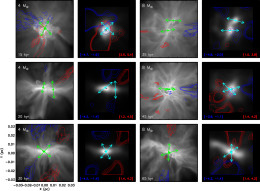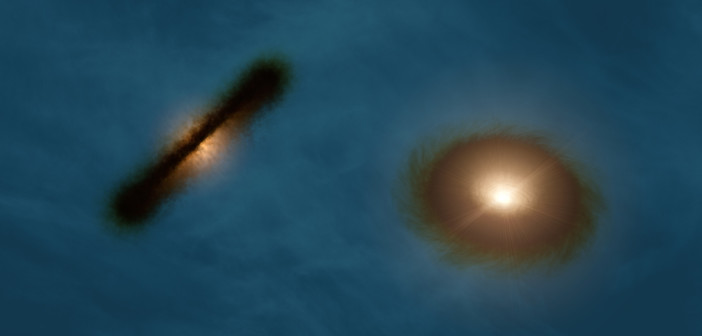More than half of all stars are thought to be in binary or multiple star systems. But how do these systems form? The misaligned spins of some binary protostars might provide a clue.
Two Formation Models
It’s hard to tell how multiple-star systems form, since these systems are difficult to observe in their early stages. But based on numerical simulations, there are two proposed models for the formation of stellar binaries:
- Turbulent fragmentation
Turbulence within a single core leads to multiple dense clumps. These clumps independently collapse to form stars that orbit each other. - Disk fragmentation
Gravitational instabilities in a massive accretion disk cause the formation of a smaller, secondary disk within the first, resulting in two stars that orbit each other.

Log column density for one of the authors’ simulated binary systems, just after the formation of two protostars. Diamonds indicate the protostar positions. [Adapted from Offner et al. 2016]
Outflows as Clues
How can we differentiate between these formation mechanisms? Led by Stella Offner (University of Massachusetts), a team of scientists has suggested that the key is to examine the alignment of the stars’ protostellar outflows — jets that are often emitted from the poles of young, newly forming stars.
Naively, we’d expect that disk fragmentation would produce binary stars with common angular momentum. As the stars’ spins would be aligned, they would therefore also launch protostellar jets that were aligned with each other. Turbulent fragmentation, on the other hand, would cause the stars to have independent angular momentum. This would lead to randomly oriented spins, so the protostellar jets would be misaligned.

Snapshots from the authors’ simulations. Left panel of each pair: column density; green arrows give protostellar spin directions. Right panel: synthetic observations produced from the simulations; cyan arrows give protostellar outflow directions. [Offner et al. 2016]
Simulations of Fragmentation
In order to better understand the alignment of protostellar outflows during binary formation, Offner and collaborators conduct a series of numerical simulations of the process of turbulent fragmentation.
The team’s radiation-magnetohydrodynamics simulations start with a spherical core with random turbulent velocities within it. The simulations then follow the formation of seeds within the core, which accrete mass and eventually launch protostellar outflows.
In total, Offner and collaborators run twelve simulations, in which five produce single stars, five produce binaries, and two produce triple star systems.
Comparison to Observations

Cumulative density function of the angles between simulated binary pairs’ protostellar outflows. The black line is the MASSES data (observations of actual binaries). The alignments from the simulations are consistent with the real observational data. [Offner et al. 2016]
Statistical analysis shows that the protostellar jets in the authors’ simulations are consistent with being randomly aligned or misaligned. This confirms what we would expect — since the systems formed at wide separations from separate gravitational collapse events — and the alignment distribution is consistent with observations of binaries in MASSES.
Offner and collaborators’ work in this study indicates that the presence of misaligned binaries in observations supports turbulent fragmentation as the mechanism for binary formation. The authors caution, however, that we’re dealing with small-number statistics: MASSES consists of only 19 binary pairs. The next step is to obtain a larger sample of observations for comparison.
Citation
Stella S. R. Offner et al 2016 ApJ 827 L11. doi:10.3847/2041-8205/827/1/L11


3 Comments
Pingback: clues to how binary stars form: it's messy
Pingback: Models of a Circumbinary Disk
Pingback: How Multiple Explosions in Space Causes Binary Stars | Robert Vowler |Business Advisory | Hershey, PA | Lifestyle